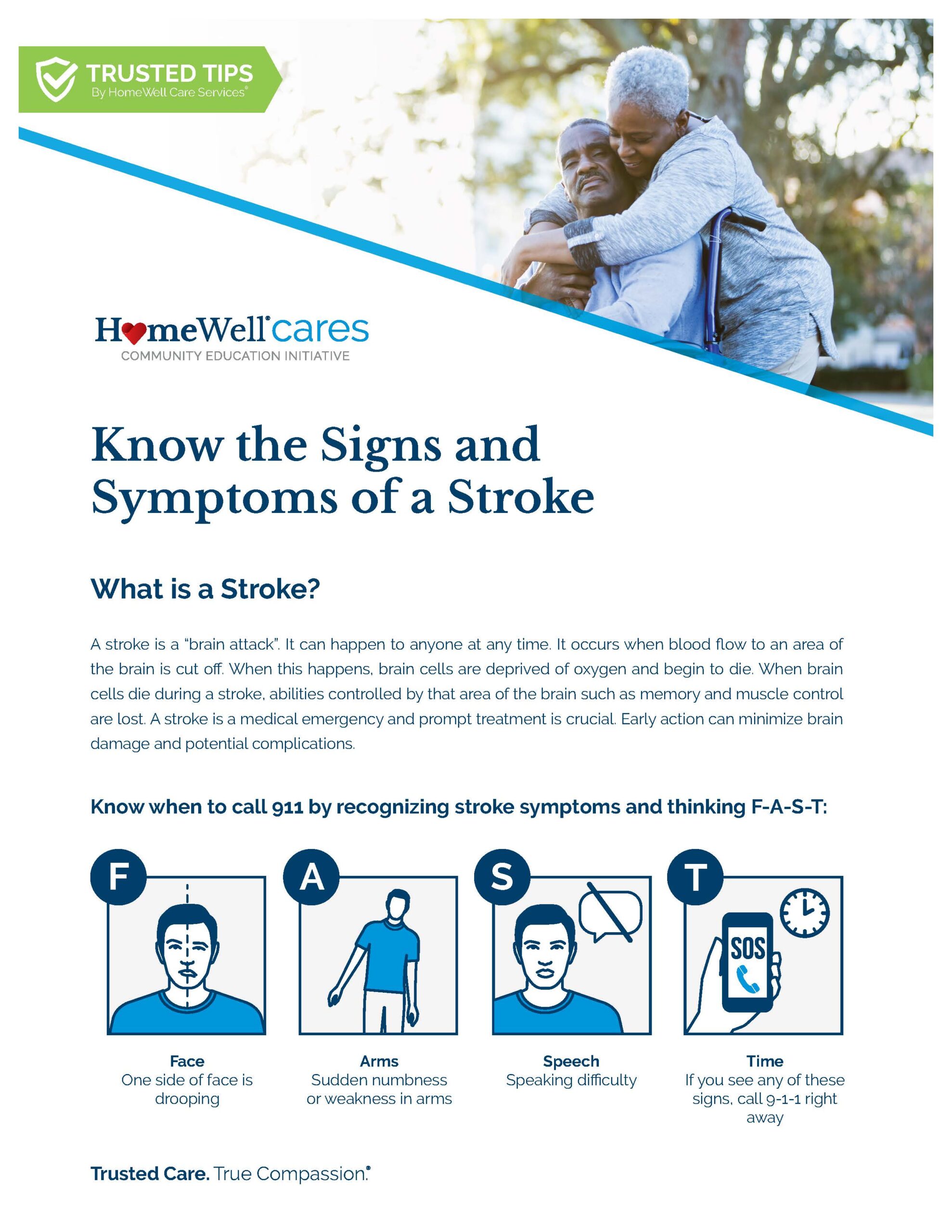Stroke Signs and Prevention Tips for Older Adults
Each year more than 795,000 people suffer from a stroke in the United States. More than 76% of these strokes were new or first-time occurrences. The risk of suffering a stroke gradually increases as we age and it is the leading cause of serious long-term disability.
Knowing the early warning signs and symptoms of a stroke can help save a life. Studies show that people who arrive at the hospital within three hours of their first symptoms often have less disability three months after a stroke than those who received delayed care *.
What is a stroke?
A stroke, also known as a “brain attack,” occurs when there is a change in the blood flow through the brain. Blood brings oxygen and nutrients to the brain cells and when that is disturbed, the brain does not receive enough oxygen to function as needed. If the cells in the brain are without oxygen for a short period of time, they may recover. However, the longer the cells are without oxygen, the more serious the recovery may be.
Different Types of Strokes:
- Ischemic Stroke
An ischemic stroke is the most common stroke type. strokes, which occur when the blood flow to the brain is blocked.* This is typically a result of fatty buildup and cholesterol in the blood vessels.
- Hemorrhagic Stroke
A hemorrhagic stroke is caused by a sudden breaking of a blood vessel in the brain, known as a hemorrhage. High blood pressure is one of the more well-known causes of this type of stroke.
- Transient Ischemic Attack (TIA)
A TIA stroke is also known as a “mini-stroke.” This is a temporary blockage in blood flow to your brain. The symptoms of a TIA stroke usually last for just a few minutes or may take up to 24 hours. It is important to remember that a mini-stroke is oftentimes a warning sign of a future stroke. You should still seek medical attention even if the symptoms are gone.
Recognize the F.A.S.T Warning Signs
Knowing the signs of a stroke can help you act quickly which makes a dramatic difference in the effects of stroke in seniors. An easy way to remember the signs is by using the acronym F.A.S.T.
(F)ace Drooping
Does one side of the face droop or is it numb? Ask the person to smile.
(A)rm Weakness
Is one arm weak or numb? Ask the person to raise both arms. Does one arm drift downward?
(S)peech Difficulty
Is their speech slurred, are they unable to speak, or are they hard to understand? Ask the person to repeat a simple sentence.
(T)ime to call 9-1-1
If you notice any of these symptoms, call 9-1-1 and seek emergency treatment immediately.
Stroke Signs in Women vs. Men
The stroke signs in men and women are similar. However, stroke symptoms in women can be less noticeable at times which means they can be more easily missed or dismissed.
According to the CDC , the risk of having a stroke is higher among women due to several individual factors such as pregnancy or birth control supplements.
Outside of the common F.A.S.T warning signs, women may experience the following symptoms:
- Nausea or vomiting
- Headache, disorientation, or confusion
- Weakness or fatigue
Take Preventative Measures
There are some health factors that can put seniors at a higher risk of having a stroke. Some of those factors are beyond our control, but a few lifestyle changes can help you minimize the risk of a stroke such as:
- Be more active
Older adults should participate in light physical activity ranging from thirty minutes to two hours each day to lower their risk of stroke.
- Eat healthy
Try to eat plenty of fruits and vegetables and foods low in saturated fat, trans fat and cholesterol.
- Limit alcohol
Alcohol can lead to high blood pressure levels. It is better to try to limit the amount of alcohol you consume.
- Quit smoking
Smoking cigarettes can increase your chances of having a stroke. If you currently smoke, consider asking your doctor for a way to help you quit.
Spread Awareness to Save a Life
Knowing the warning signs and symptoms of a stroke can not only save your life, but it can also save the life of someone you love.
Download our Trusted Tips factsheet to share with others and help keep your family informed.
After Stroke Support
Regaining your strength and independence after a stroke can be a challenge. Our GoHomeWell Post Medical Care Program can help provide you with peace of mind after returning from a hospital stay. Click here to learn about how we can help you rebuild your independence safely, and with the assistance of a dedicated Care Manager and supportive caregiver.
*Source: Centers for Disease Control and Prevention
